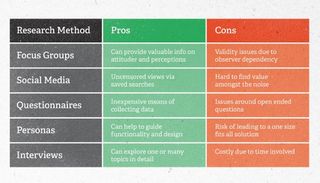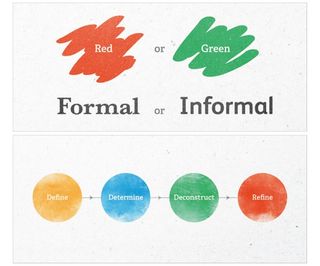Understand your audience with good research
Good research isn’t just about finding how many unique visitors you have. Rob Mills sets out techniques to really get to know your users
This article first appeared in issue 233 of .net magazine – the world's best-selling magazine for web designers and developers.
Before I entered the design world I was an audience research executive at BBC Wales. This gave me a valuable grounding in the importance of audiences, research and having data to support any decisions you make. It also taught me that there’s a big difference between knowing your audience and understanding your audience.
Knowing is associated with top-level data such as having 23,000 unique visitors a month to a site. Understanding your audience is about finding out as much as possible about the people behind the numbers including their social and cultural situations, media consumption, likes, dislikes and needs.
Why understand?
Understanding means that you can make informed decisions when designing for a target audience. Doing research to establish who the audience is and then digging deeper to understand them is always time well spent. Content strategist Relly Annett- Baker nicely summarised this on the Creating Web Content course I recently completed: ‘I do not trust stakeholders to know their audience unless they have conducted some sort of research. They either talk about the audience they had when they were still largely in contact with them day-to-day, or the one they’d like.’ Even if the research you undertake confirms what you already assumed about the audience it is still worth having that validation.

By understanding the audience you can make informed decisions with regard to colours, tone of voice, typefaces and imagery. You’ll understand the cultural situation of your audience, so if a certain colour has different connotation in one culture to another, then you can choose the best palette so as not to offend.
Targeting content
Targeting is vital: the web is evolving quickly and marketplaces are increasingly competitive. More choice has resulted in fragmentation, so audiences are spread more thinly and you need to work hard to get them – and keep them. Users are selective about where they spend their time online, and this is a concern if they are consumers with money to spend.
Knowing vs understanding
Top-level tricks of the trade such as Google Analytics and the Jetpack WordPress plug-in provide an overview of your audience, but address knowing more than understanding. With Analytics you can find out your users’ language, location, device, how they came to your site, their user journey and how long they stayed – all useful information, but specific to a single visit, and offering nothing more about the people behind the numbers.
Establishing a framework
To dig deeper you need to choose the research methods that best offer the level of detail that you need. Then you need to derive meaning from the data to find stories within. The first step is to establish your objectives. It might be best to categorise the audience information you aim to obtain, perhaps in the following way:
Get the Creative Bloq Newsletter
Daily design news, reviews, how-tos and more, as picked by the editors.
- Basics
- Lifestyle
- Media
Basics could cover overall user numbers, gender splits, age segmentation, nationalities and locations. Lifestyle data is concerned with education, employment, socioeconomic status, health, finance and religion. Finally, Media provides insight into your users’ consumption of newspapers and magazines, technology, television and radio – and of course, the internet.
You might want to find out what newspapers and magazines member of your audience read. What sort of TV programmes do they watch? Which radio stations do they listen to? How much time do they spend online, and on what devices? Answers to these questions start to create a picture of your audience as people rather than numbers. Add Basics and Lifestyle data and you’ll have a thorough understanding.

Choosing your tools
The research methods available can include questionnaires, focus groups, persona generation, social media and interviews. In addition, you can’t beat simple audience observation. There are pros and cons for each method, so you need to determine which is best suited to your budget and objectives.
Questionnaires can be a cost-effective way to gather data, but the design of the questionnaire – what you ask and how you ask it – is vital in getting valid data that you can analyse. Open-ended questions enable the participants to share whatever they like, but can be harder to derive meaning from. Services like SurveyMonkey let you to design surveys, and even help you target them at the right audience.
Interviews can offer a large amount of information as you are free to explore topics in detail. Thought needs to be given to the questions, but there is also scope to react to something that has been said and digress as needed. But owing to the time involved, interviews can be an expensive research method.
It seems focus groups divide people down the line. Some love them and others see no value in them. They can provide insightful information on attitudes and perceptions, but their value is largely dependent on the facilitator and moderator. They must withdraw the information, make sure it isn’t prompted or biased, and be experienced at observing a focus group environment.
Social media isn’t a research method as such, and shouldn’t be used for this sole purpose: it can be difficult to find any insight among the high volume of noise. That said, with saved searches and lists you can find out what a wide audience are saying about a certain product, event, service, brand or company.
Another Marmite-style approach is personas. Some people swear by them and others wish they were banished for good. If created effectively they can help guide functionality and design. They need to be communicated to the client well so they can use them accurately, because there’s always a risk that they offer a ‘one size fits all’ solution.
Once you have gathered the data, you need to extract the meaning from it and gather insights. If you are starting on a new website, you should make all your subsequent design decisions in the light of these insights. If you have an existing website, you should review it in light of your research results.

Repeating the process
Audiences don’t change overnight, but their behaviour can fluctuate as rapidly as anything else on the web. For this reason, it is worth carrying out research at regular intervals to make sure you are still targeting the right people. A good process here is Define, Determine, Deconstruct and Refine:
- Define – your objectives
- Determine – your audience through research
- Deconstruct – find the stories, analyse the data, and extract the insights
- Refine – as needed, at suitable intervals
If you do find that the audience profile has changed since the last time you carried out research, adapt the site in line with this new insight.
Considering the client
Finally, remember that the objectives and research framework you establish should be related to your client’s business goals. Don’t just think about what you want to know as a developer; instead, consider what you need to find out about the target audience in order to help your client achieve those goals.
Understanding your audience in this way will help you make informed decisions, backed up by hard data. This should make selling your designs to the client easier, because you’ll be designing with their business goals in mind. Just remember: knowing is useful, but understanding is essential.
Images: Gareth Strange
Words: Robert Mills
Rob is a project manager and writer from near Cardiff in the UK. A media and journalism graduate, he has a keen interest in communication and psychology and how this can be related to and applied to the web. Follow him on Twitter.

Thank you for reading 5 articles this month* Join now for unlimited access
Enjoy your first month for just £1 / $1 / €1
*Read 5 free articles per month without a subscription

Join now for unlimited access
Try first month for just £1 / $1 / €1
The Creative Bloq team is made up of a group of design fans, and has changed and evolved since Creative Bloq began back in 2012. The current website team consists of eight full-time members of staff: Editor Georgia Coggan, Deputy Editor Rosie Hilder, Ecommerce Editor Beren Neale, Senior News Editor Daniel Piper, Editor, Digital Art and 3D Ian Dean, Tech Reviews Editor Erlingur Einarsson and Ecommerce Writer Beth Nicholls and Staff Writer Natalie Fear, as well as a roster of freelancers from around the world. The 3D World and ImagineFX magazine teams also pitch in, ensuring that content from 3D World and ImagineFX is represented on Creative Bloq.
